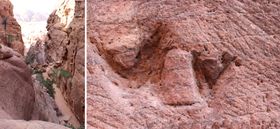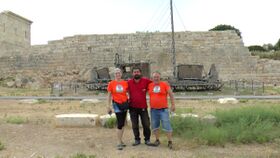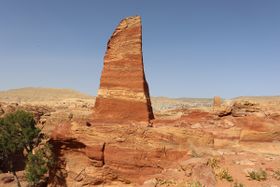Faszinierende Entdeckung über den Tempeln Petras
(dg) Petra war vor mehr als 2.000 Jahren das Handelszentrum der Nabatäer in Jordanien, das wir Anfang Mai mit unserem ABORA-Filmteam besuchten. Neben den faszinierenden Fassadentempeln beherbergt Petra noch eine weitere Rarität – das Plateau der Obelisken. Unterhalb des „Hohen Opferplatzes“ ragen zwei gewaltige Obelisken in den Himmel, die uns viel über das hohe astronomische Wissen der Nabatäer verraten.
Es ist eine der großen Fragen der Archäologie, ob das monumentale Petra wirklich nur eine Stätte der Toten oder eben eine Ort der Gelehrten war. Als Beleg für die zweite These führte uns der Archäologe Mamoun Al Navafleh über einen steilen Pfad hoch über die Tempel von Petra.
Die Mehrheit der Archäologen hält den zentralen Bereich Petras für Grabtempel, was vielfach auch in den Bezeichnungen der Anlagen zum Ausdruck kommt. Der jordanische Archäologe Mamoun Al Navafleh vertritt dagegen eine andere Auffassung. Seiner Meinung nach sind es heilige Orte, die vielfach eine astronomische Ausrichtung aufweisen. So sollen in Petra viele Gelehrte aus nah und fern hier eine Stadt der Wissenschaft gegründet haben. Für diese These sprechen neben der Notwendigkeit, als Händler Geographie und Astronomie für die Orientierung zu betreiben, eben zahlreiche architektonische Merkmale. Der Tempel der Obelisken am Eingang vor dem Siq, zahlreiche erhaltene Plattformen für Obelisken und natürlich die Obelisken auf der Plattform des Hohen Opferplatz sind dafür ein steinerner Beleg.
Nur wenige Touristen wagen den anstrengenden Aufstieg durch das steile Felsental auf das Hochplateau, das sich mehr als 200 m über dem römischen Amphitheater befindet. Das Plateau entstand durch massiven Steinabbau. Dennoch planten die Erbauer die Errichtung zweier großer Monolithen, die nachweislich zur Sommer- und Wintersonnenwende mit ihren Schatten aufeinander zuwiesen. Sie sind exakt in Ost-West-Achse gebaut. Auch ein großes Wasserbecken am Hohen Opferplatz verrät dem Kundigen, dass dies nicht allein für rituelle Waschungen, sondern für astronomische Beobachtungen errichtet wurde.
Das hohe astronomische und damit auch mathematische Wissen der Nabatäer kommt überall in der Architektur zum Ausdruck. Neben dem „Schatzhaus des Pharaohs“ (Khazne al-Firaun) ist es vor allem das „Grab der Obelisken“ am Eingang des Siq. Es war in Wirklichkeit eine „Unwetterwarnanstalt“ für die Nabatäer. Ein Überflussbecken diente dort als Messvorrichtung für Sturzfluten. Gelichzeitig symbolisierten die Obelisken auch die vier Jahreszeiten, deren Sonnenstände sich leicht an den vier Monolithen ablesen und berechnen lassen konnten.
Der Archäologe Mamoun Al Navafleh zeigt damit auf, dass sich viele Gewissheiten der Altertumswissenschaft bei näherer Überprüfung auch anders interpretieren lassen. Diese spannenden Forschungen werden wir sowohl in unserem Film von keyper MEDIA HOUSE als auch in meinem ABORA TV Kanal in Bälde präsentieren, um uns weiter erkenntnisoffen den Rätseln der Archäologie zu zuwenden.
Die Obelisken von Petra bekommen nur wenige Touristen zu Gesicht. Sie sind in einer solaren Ausrichtung und symbolisieren hohes astronomisches Wissen der Nabatäer. Das Bild zeigt den östlichen Obelisken. //
Very few tourists see the Petra obelisks. They are in a solar alignment and symbolize high astronomical knowledge of the Nabataeans. The picture shows the eastern obelisk.Majestätisch erheben sich die Obelisken mehr als 200 m über den Fassadentempeln von Petra. Ihre Erbauer ließen diese Monolithen absichtlich stehen, wie die Abbaurillen auf dem Boden des Grundgesteins dokumentieren. Weit unterhalb im Tal erkennt man die Fassadentempel, die mit Sicherheit alles andere als reine Gräber waren. //
They rise majestically more than 200 m above the façade temples of Petra. Their builders left these monoliths on purpose, as evidenced by the excavation grooves in the bedrock floor. Far below in the valley you can see the facade temples, which were certainly anything but pure tombs.Die Messungen der jordanischen Archäologen zeigen, dass beide Obelisken exakt auf 270° ausgerichtet stehen. Damit erlauben die Steine eine exakte Vermessung des Laufes der Sonne im Jahresverlauf. An den Sonnenwenden im Jahr berühren sich jeweils die Schatten der beiden Obelisken. //
The measurements of the Jordanian archaeologists show that both obelisks are aligned exactly at 270°. The stones thus allow an exact measurement of the course of the sun over the course of the year. At the solstices in summer and winter, the shadows of the two obelisks touch each other.Auf dem Weg zum Obeliskenplateau zeigte uns Mamoun dieses Steinmetzzeichen. Es zeigt einen Obelisken mit einem kleineren linken und einem größeren rechten Keil als Symbolik für die Winter- und Sommersonnenwende! Das linke Bild zeigt das grandiose Felsental, das zum Obeliskenplateau führt. Der Auf- und Abstieg ist mühsam. Dafür belohnt es den mutigen Wanderer mit einem faszinierenden Ausblick über Petra. //
On the way to the Obelisk Plateau, Mamoun showed us this stone carving mark. It shows an obelisk with a smaller left wedge and a larger right wedge as symbolism for the winter and summer solstices! The picture on the left shows the grandiose rocky valley that leads to the Obelisk Plateau. The ascent and descent is difficult. In return, it rewards the brave hiker with a fascinating view over Petra.„Das Grab der Obelisken“. Es steht kurz vor dem Eingang des Siq. Es war in eine „Unwetterwarnanstalt“ für die Nabatäer und hatte durch den Bezug zum Wasser alles andere als eine Grabfunktion. Außerdem weisen die Obelisken auf eine weitere Sinngebung hin. Sie demonstrieren ähnlich wie im alten Ägypten, dass hier eine königliche Priesterkaste herrscht und mit ihren astronomischen Kulten die Welt erklären konnte. Die unterere Tempelzentrale weist ganz Altar-Architektur auf. Nichts deutet hier auf ein altes Grab hin! //
"The Tomb of the Obelisks". It stands just before the entrance of the Siq. It was used as a "storm warning facility" for the Nabataeans and, due to its connection to the water, had anything but a burial function. In addition, the obelisks point to another meaning. Similar to ancient Egypt, they demonstrate that a royal caste of priests rules here and could explain the world with their astronomical cults. The lower temple central exhibits all altar architecture. Nothing here indicates an old grave!Dieses Wasserbecken untermauert diese These. Das Becken war so angelegt, dass es sich bei Regengüssen schnell füllte und so die Nabatäer vor Sturzfluten warnte. Sobald es überlief wurden die Nabatäer im Tal alarmiert und der Siq geschlossen. Dieses Bauwerk dokumentiert das hohe hydraulische und damit ingenieurstechnische Wissen der Nabatäer. //
This water basin supports this thesis. The basin was designed to fill up quickly when it rained, warning the Nabataeans of flash floods. As soon as it overflowed, the Nabataeans in the valley were alerted and the Siq closed. This building documents the high hydraulic and thus engineering knowledge of the Nabataeans.Der östliche Pfeiler auf dem Obeliskenplateau. Nach Mamoun hat er die Form eines Dhau-Segels, was auch wieder ein Querverweis auf das Dreieck-Quersegel im Felsental des Siq darstellen kann. Im Hintergrund sieht man den westlichen Obelisken. //
The eastern pillar on the Obelisk Plateau. According to Mamoun, it has the shape of a dhow sail, which can also represent a cross-reference to the triangular sail in the rock valley of the Siq. In the background you can see the western obelisk.Die prächtige Fassade des „Schatzhaus des Pharaos“. Für Mamoun alles andere als ein Grabtempel. Vielmehr sieht er in der Anlage eine große Bibliothek, deren Fassade mit vielen astronomischen Alignements im griechischen Styl dekoriert wurde. Im oberen Dachbereich der Fassade fallen die beiden wuchtigen, angedeuteten Obelisken auf, die als herrschaftliche Symbole himmelwärts aufstreben. Diese antike Anlage ist wirklich einmalig und zu Recht UNESCO Weltkulturerbe! //
The magnificent facade of the "Pharaoh's Treasury". Anything else but a funerary temple for Mamoun. Rather, he sees a large library in the complex, the facade of which has been decorated in Greek-style with many astronomical alignments. In the upper roof area of the façade, the two massive, indicated obelisks, which rise skyward as stately symbols, are striking. This ancient complex is really unique and rightly a UNESCO World Heritage Site!
Fascinating discovery over the temples of Petra
More than 2,000 years ago, Petra was the trading center of the Nabataeans in Jordan, which we visited with our ABORA film team in early May. In addition to the fascinating facade temples, Petra manages another rarity - the plateau of the obelisks. Below the "High Place of Sacrifice" two huge obelisks rise into the sky, which tell us a lot about the high level of astronomical knowledge of the Nabataeans.
It is one of the great questions of archeology whether the monumental Petra was really only a place of the dead or just a place of scholars. As evidence for the second thesis, the archaeologist Mamoun Al Navafleh led us up a steep path high above the temples of Petra.
The majority of archaeologists consider the central area of Petra to be a funerary temple, which is often reflected in the names of the complexes. Jordanian archaeologist Mamoun Al Navafleh, on the other hand, takes a different view. In his opinion, they are sacred places that often have an astronomical orientation. Many scholars from near and far are said to have founded a city of science in Petra. In addition to the need for traders to practice geography and astronomy for orientation, numerous architectural features also speak in favor of these. The Temple of the Obelisks at the entrance in front of the Siq, numerous preserved platforms for obelisks and of course the obelisks on the platform of the High Place of Sacrifice are stone proof of this.
Few tourists dare the strenuous ascent through parts of the rocky valley to the high plateau, which is more than 200 m above the Roman amphitheater. The plateau was created by massive stone quarrying. Nonetheless, the builders planned to erect two large monoliths, which have been shown to face each other with their shadows at the summer and winter solstices. They are built exactly in the east-west axis. A large water basin at the High Place of Sacrifice also reveals to the expert that this was not only built for ritual ablutions, but also for astronomical observations.
The high level of astronomical and thus also mathematical knowledge of the Nabataeans is expressed everywhere in architecture. In addition to the "Treasury of the Pharaohs" (Khazne al-Firaun), it is above all the "Tomb of the Obelisks" at the entrance to the Siq. It was actually a "storm warning facility" for the Nabataeans. An overflow basin served there as a measuring device for flash floods. At the same time, the obelisks also symbolized the four seasons, whose positions of the sun could be easily read and calculated from the four monoliths.
The archaeologist Mamoun Al Navafleh thus shows that many certainties of classical studies can also be interpreted differently on closer examination. We will soon be presenting this exciting research both in our film by keyper MEDIA HOUSE and on my ABORA TV channel, so that we can continue to turn to the mysteries of archeology with an open mind.







